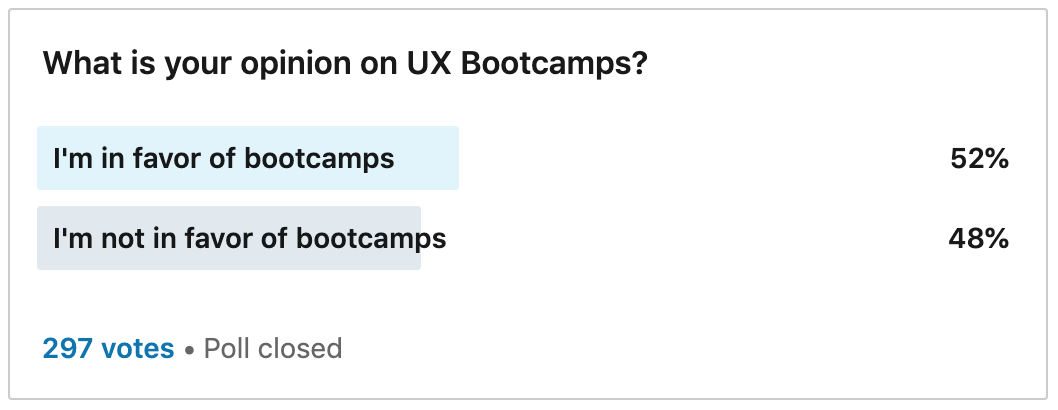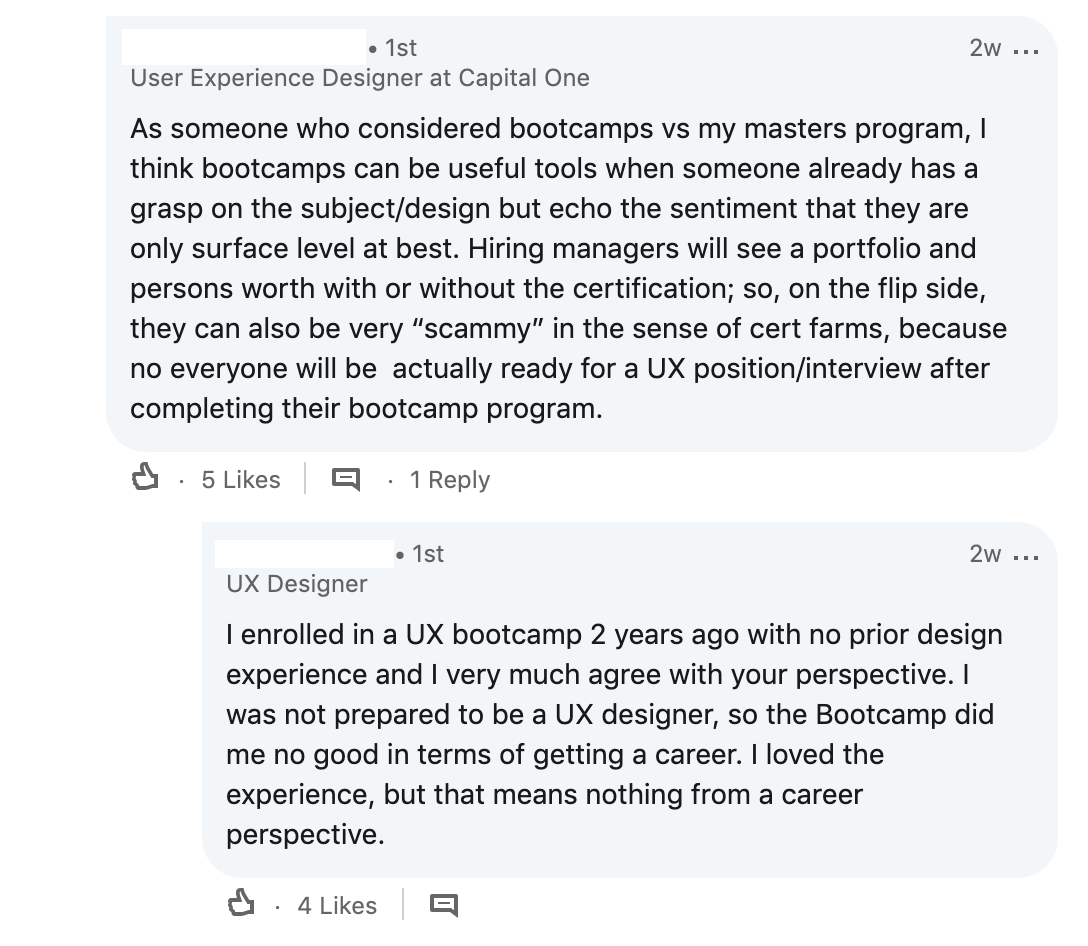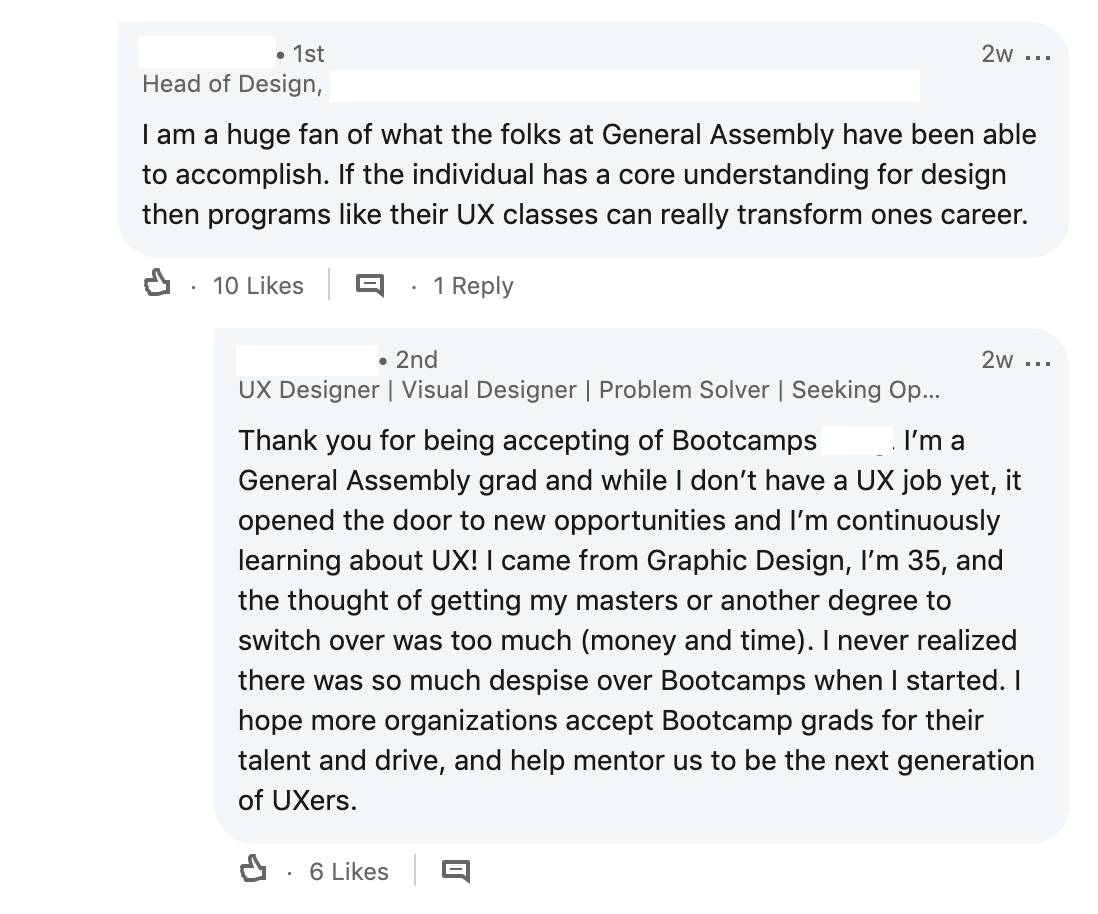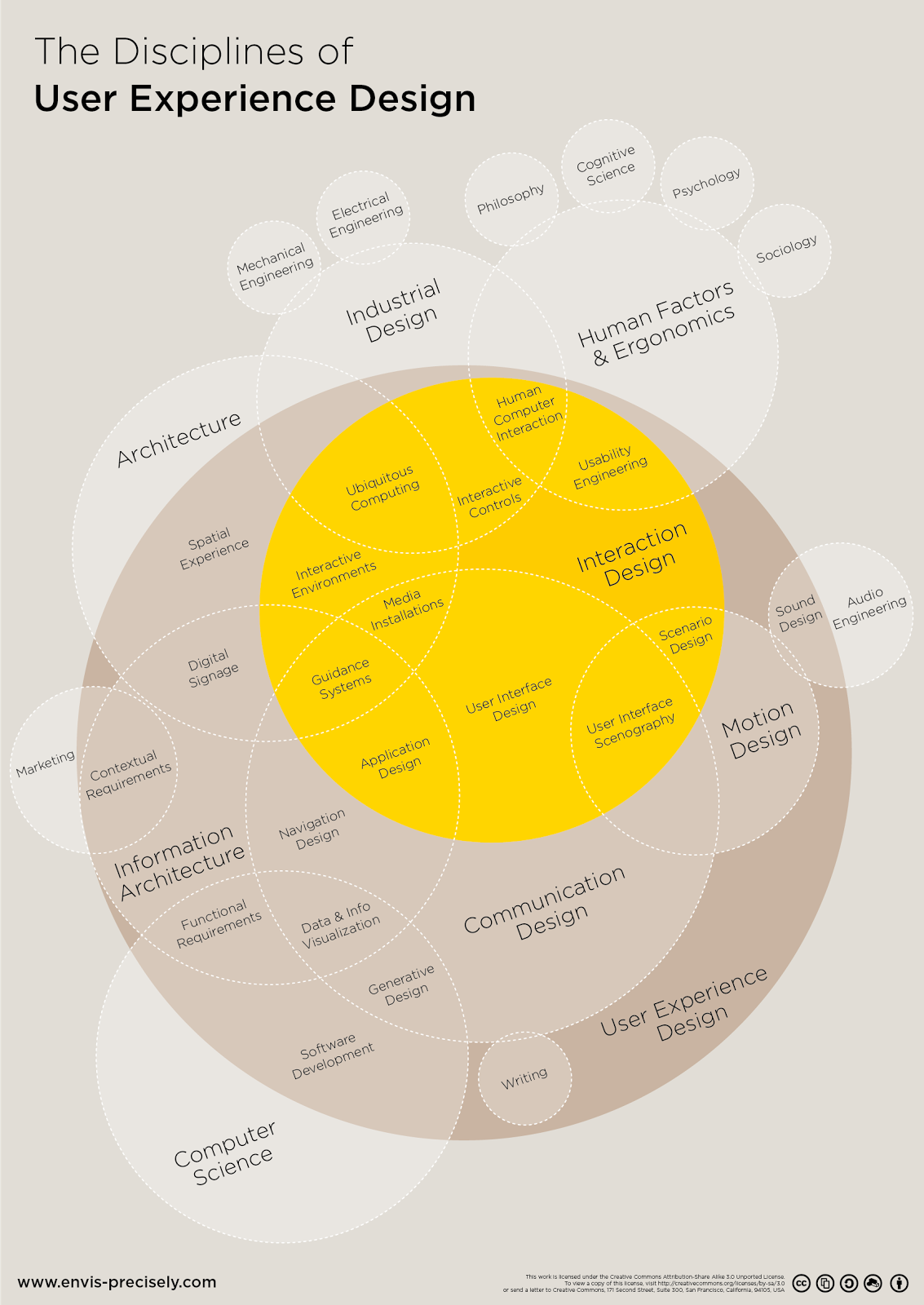The Current State of UX Bootcamps
Bootcamps have emerged in recent years as a popular alternative to a university degree for people interested in pursuing a career in user experience. These days there is no shortage of places to get your quick fix of UX expertise including, but not limited to programs such as DesignLab, Springboard, CareerFoundry, Designation, Tradecraft, and General Assembly. All of these programs provide students with a basic understanding of user-centered design and a portfolio of work to present to future employers. This article is not a critique or review of any specific UX bootcamp. Instead, it takes a broader view of the educational value and industry-wide implications these programs have on the UX profession.
Taking the Pulse of the Industry
Last month I conducted a poll of nearly 300 UX professionals to see what they had to say about the current state of UX bootcamps. The results were surprisingly split, with a slight majority saying that they were in favor of bootcamps.

The poll results also included 50+ opinions on the state of bootcamps. Those that were not in favor of these programs often felt that they inadequately prepared graduates for a job in UX and that they made false promises to students.

Some of the respondents praised and supported bootcamps. They felt that these programs provide a solid foundation and that it ultimately does not matter how an individual learns about UX as long as they have a strong body of work.

Some responses were extremely passionate for or against bootcamps, and at times, the conversations became heated. It seems that this topic has struck a nerve with UX people, and as an ever-increasing number of individuals complete these programs it is something that our field needs to address.
Bootcamps: The Fast Food Industry of UX

Do you want fries with that certification?
Many individuals are allured by these “get into UX quick” schemes that expedite the learnings of a variety of UX skills anywhere from a few weeks to a few months of coursework. While fast food is cheap, most bootcamp programs are not. Online programs range from a few thousand dollars to in-person programs upwards of $10,000 or more. Some of these programs offer a job guarantee after graduating. While this sounds like a “too good to be true” scenario, it certainly can be.
UX isn’t about training people how to flip burgers.
A mile wide and an inch deep
Bootcamps try to give students a crash course in every design and research technique so that they can put it on their resume. This provides the student with some exposure to these concepts, but it doesn’t provide any level of mastery.
A short conversation with a bootcamp graduate quickly reveals their lack of understanding of the Why. Why did you create an empathy map for this project? Why might this interaction cause confusion for users? Why did you decide to include a hamburger menu in your prototype? Bootcamps teach students what they need to do, but very little about the rationale and underpinnings behind the actions.
One of the appealing and most challenging aspects of being in UX is that it is a highly interdisciplinary field. This requires an individual to be well versed in disciplines beyond UI such as cognitive science, psychology, visual perception, and technical writing, to name a few.

Bootcamps are no substitution for an academic education
Academic programs provide a solid foundation of knowledge that can’t be achieved in a bootcamp. An academic program may have one or more semester-length courses in human-computer interaction while a bootcamp will try to cover this topic in a short article for students to consume. University faculty have established credentials that make them qualified to teach their subject matter; this isn’t always the case with bootcamps. University programs are also designed to teach students to think for themselves and explore concepts in ways that go beyond putting a deliverable in their portfolio.

The UXD Lab at Bentley University (pictured above) provides students with a state of the art facility to conduct user research.
Students in the University of Baltimore’s Interaction Design & Information Architecture program take a class called: Humans, Computers & Cognition which “introduces concepts, theories, and methods that support the study of human-computer interaction and user-centered system design. Students apply concepts from cognitive psychology and visual processing to explore human problem-solving, learning, knowledge representation, and problems of interface design.”
The reality is that someone who completed a bachelor’s, master’s, or Ph.D. degree in a field related to user experience is going to have a much deeper and more holistic background than someone who learned about UX in a 12-week bootcamp.
Cookie-cutter portfolios
If you’ve seen one portfolio from a bootcamp graduate, you’ve seen them all. They are filled with pages upon pages of templated empathy maps, Point of View & How Might We statements, personas, storyboards, and wireframes.
When I interviewed bootcamp students and asked why they put everything into their portfolio case studies, most replied that they thought that was what they were supposed to do, and really had no idea why. They were terribly afraid of leaving something out that a potential employer might want to see.
In the majority of these portfolios, students took the exact same approach and methodology to complete their projects. These students were also not equipped to tell stories about the user-centered design process that they followed or answer any probing questions about their work.
What they don’t teach in bootcamps is that there is no one size fits all process in UX.
Market saturation
The explosion of bootcamps is a direct result of the consistently strong demand for UX professionals. Companies are continually hunting for new UX talent and often have a very difficult time finding experienced UX designers and researchers. Bootcamps provide a vocational approach and streamlined solution to meet that need.
Bootcamps continue to expand the number of enrolled students and new programs seem to appear each year. There is already evidence that students coming out of bootcamps are having difficulty finding jobs in the industry as they are competing for a limited number of entry-level positions.
There is a risk that employers may start to feel that hiring someone fresh out of a bootcamp is “good enough” to satisfy their company’s basic UX needs without realizing that these individuals are not qualified to do the job. There is the potential to create a very large pool of individuals with a superficial understanding of UX principles flooding the market.
Potential to erode the carefully built credibility of UX
It has taken decades for the field of user experience to mature, and to be recognized as a valued and trusted partner in the product development process. The formalization of UX occurred through the establishment of professional associations, academic programs, user-centered design methods, and countless hours of user research studies. There are many paths to become a UX professional, but no matter the approach, it has not been without an enormous amount of formal training, self-paced learning, mentorships, and lessons learned through project experience.
Unleashing thousands of individuals each year who are fresh out of a bootcamp into a full-time UX role is dangerous. While well-intentioned, these graduates are only equipped with the most basic understanding of UX principles combined with a superficial ability to crank out UX deliverables.
Graduates from these programs are lulled into a false sense of mastery and most are not yet ready to take on the real-world challenges faced on a product development team. Many will fail to properly articulate and defend their design choices or incorrectly conduct user research that may lead to the wrong conclusions. Over time, product teams may begin to devalue and not trust the contributions from their UX team members.
There are Diamonds in the Rough

Not all bootcamp experiences are the same and neither are the students. There are many students that complete these programs and go on to highly successful UX careers. Some students already have related industry and/or prior academic experience and are just looking to update or further enhance their UX skills. I’ve personally worked with bootcamp students who have a lot of raw talent and were able to grasp and apply UX concepts quickly. While they are just beginning their journey into UX, they are incredibly driven, and all of them took the initiative to go beyond the scope of their bootcamp program.
There Might be Hope for Bootcamps
I strongly believe that there is room in the UX field for those without an advanced degree or 10 years of UX work experience. I also believe that bootcamps have the potential to destroy the carefully established credibility of UX professionals and to destabilize the UX hiring market.
However, instead of completely kicking bootcamps out of the industry, I think we just need to just give them a swift kick in the butt.
There needs to be fundamental changes in how these programs are run and how they are positioned in the industry:
- Change the teaching format from what to why. Rather than trying to give students a crash course in every design and research technique so that they can put it on their resume, the programs should focus on teaching them how to think like a UX designer.
- There is no one size fits all process to UX. Bootcamps should provide more real-world case studies and teach about the diversity of projects that UX professionals encounter. They should also provide students with a more critical analysis of UX techniques so that students understand the benefits and limitations of certain methods.
- Make it more competitive to get in. Some programs now require students to take a Design 101 course as a prerequisite to entering the program. Student’s work in this course should be evaluated to determine if they are ready for a full bootcamp program. Not everyone is immediately cut out to be a UX professional, and some people need more time to master the necessary skills.
- Assist transition into UX through internships and apprenticeships. Most students have the expectation that they will gain full-time employment as a UX professional immediately after graduating. The reality is that there are a limited number of entry-level UX jobs available, and many students aren’t yet experienced or skilled enough to fill these roles. Bootcamps should partner with hiring managers to establish internships and apprenticeships to help students gain the necessary experience.
- Position bootcamps as a way to get started, and not as a quick fix to a high paying UX job. No matter what your path is to join the field of UX there is always a lot to learn and many skills to master. There are no shortcuts to gaining hands-on experience which includes learning from your mistakes and working on challenging real-world projects with a team.